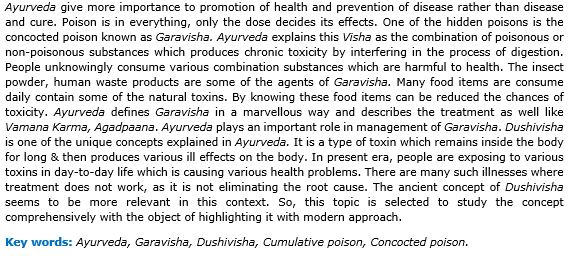Effect of Garavisha and Dushivisha on Human Population - In Present Era
DOI:
https://doi.org/10.21760/jaims.8.3.18Keywords:
Ayurveda, Garavisha, Dushivisha, Cumulative poison, Concocted poison.Abstract
Ayurveda give more importance to promotion of health and prevention of disease rather than disease and cure. Poison is in everything, only the dose decides its effects. One of the hidden poisons is the concocted poison known as Garavisha. Ayurveda explains this Visha as the combination of poisonous or non-poisonous substances which produces chronic toxicity by interfering in the process of digestion. People unknowingly consume various combination substances which are harmful to health. The insect powder, human waste products are some of the agents of Garavisha. Many food items are consume daily contain some of the natural toxins. By knowing these food items can be reduced the chances of toxicity. Ayurveda defines Garavisha in a marvellous way and describes the treatment as well like Vamana Karma, Agadpaana. Ayurveda plays an important role in management of Garavisha. Dushivisha is one of the unique concepts explained in Ayurveda. It is a type of toxin which remains inside the body for long & then produces various ill effects on the body. In present era, people are exposing to various toxins in day-to-day life which is causing various health problems. There are many such illnesses where treatment does not work, as it is not eliminating the root cause. The ancient concept of Dushivisha seems to be more relevant in this context. So, this topic is selected to study the concept comprehensively with the object of highlighting it with modern approach.
Downloads
References
Vaidya Yadavaji Trikamji Acharya editor Charak Samhita of Agnivesha elaborated by Charak & Drudhabala by Chakrapanidatta, Chikitsasthana 23/31, Chaukhamba Surabharati Prakashan, Varanasi, 2009, p.g.573.
Amarkosh by Amarsimha: 2nd edition,1976.
Ayurvediya Sabdakosa (Sanskrti Sanskrit): V.M. Joshi and N.H. Joshi, Maharashtra Rajya Sahitya Ani Sanskrit Mandal, Mumbai, 1968.
Shastri A. editor Sushrut Samhita, Kalpasthana, 2/33, Varanasi, Choukhamba Sanskrita Sasnthana, Reprint 2007, p.no.424.
Sapana Khatri, Vipin Kumar and Anita Sharma, Role of Dushivisha as Etiological Factor of Mandal Kustha w.s.r. to Psoriasis, NIA, Jaipur.
Agnivesha, Charak Samhita of Acharya Charak, Charak & Dhridhabalakrit, edited by Dr.Brahmananda Tripathi, Chikitsa sthan. Ch.07, ver 23. Reprint/edition Varanasi: Chukhmba Sanskrit Sansthan, 2013. P.no.305.
Shusruta Samhita of Maharsi- Susruta, English edited by G. D. Singhal. Part-2, kalpasthan. Ch. 2/30-32. Reprint/edition Delhi: Chaukhamba Sanskrit Pratishthan,2007, pg no. 570.
Shusruta Samhita of Maharsi- Susruta, English edited by G. D. Singhal. Part-2, kalpasthan. Ch. 2/33. Reprint/edition Delhi: Chaukhamba Sanskrit Pratishthan,2007, pg no. 570.
Shastri A.,editor, Sushruta Samhita, Kalpsthana,2/50-52,Varanasi,Choukhamba Sanskrit Sasnthana. Reprint 2007.
MurthyK.S.,editor,AstangaSangraha,Uttarsthana40/148,vol.3,2ndedition,Choukhamba Orientalia,2000.P.370
Sharma.R.K.,editor,CharakaSamhita,Chikitsa sthana,23/61-64,Varanasi,Choukhamba Sanskrit sansthana,P.343.
Shastri A.,editor, Sushruta Samhita, Kalpsthana,2/31,Varanasi,Choukhamba Sanskrit Sasnthana.
Modern Medical Toxicology, VV Pillay, Jaypee Brothers Medical Publishers (P) LTD 16th edition 2011, page no 517
Modern Medical Toxicology, VV Pillay, Jaypee Brothers Medical Publishers (P) LTD 16th edition 2011, page no 407
C. Y. Jagtap, B. K. Ashok, B. J. Patgiri, P. K. Prajapati, B. Ravishankar, 24082351Acute and Subchronic Toxicity Study of Tamra Bhasma (Incinerated Copper) prepared from Ashodhita (Unpurified) and Shodhita (Purified) Tamra in Rats, Indian J Pharm Sci. 2013 May-Jun; 75(3): 346352.doi:10.4103/0250-474X.117433 PMCID: PMC3783753 PMID:
C. Y. Jagtap, B. K. Ashok, B. J. Patgiri, P. K. Prajapati, B.Ravishankar, 24082351Acute and Subchronic Toxicity Study of Tamra Bhasma (Incinerated Copper) prepared fromAshodhita (Unpurified) and Shodhita (Purified) Tamra in Rats, Indian J Pharm Sci. 2013 May-Jun; 75(3): 346352.doi: 10.4103/0250-474X.117433 PMCID: PMC3783753 PMID:
Modern Medical Toxicology, VV Pillay, Jaypee Brothers Medical Publishers (P) LTD 16th edition 2011, page no 518
Modern Medical Toxicology, VV Pillay, Jaypee Brothers Medical Publishers (P) LTD 16th edition 2011, page no 519















